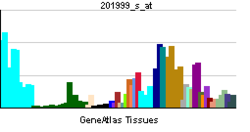- DYNLT1
-
Dynein light chain Tctex-type 1 is a protein that in humans is encoded by the DYNLT1 gene.[1][2][3]
Cytoplasmic dynein is the major motor protein complex responsible for minus-end, microtubule-based motile processes. Each dynein complex consists of 2 heavy chains that have ATPase and motor activities, plus a group of accessory polypeptides. TCTEX1 is a dynein light chain involved in cargo binding (Chuang et al., 2005).[supplied by OMIM][3]
References
- ^ Watanabe TK, Fujiwara T, Shimizu F, Okuno S, Suzuki M, Takahashi E, Nakamura Y, Hirai Y (Jul 1996). "Cloning, expression, and mapping of TCTEL1, a putative human homologue of murine Tcte1, to 6q". Cytogenet Cell Genet 73 (1-2): 153–6. doi:10.1159/000134329. PMID 8646886.
- ^ Pfister KK, Fisher EM, Gibbons IR, Hays TS, Holzbaur EL, McIntosh JR, Porter ME, Schroer TA, Vaughan KT, Witman GB, King SM, Vallee RB (Nov 2005). "Cytoplasmic dynein nomenclature". J Cell Biol 171 (3): 411–3. doi:10.1083/jcb.200508078. PMC 2171247. PMID 16260502. http://www.pubmedcentral.nih.gov/articlerender.fcgi?tool=pmcentrez&artid=2171247.
- ^ a b "Entrez Gene: DYNLT1 dynein, light chain, Tctex-type 1". http://www.ncbi.nlm.nih.gov/sites/entrez?Db=gene&Cmd=ShowDetailView&TermToSearch=6993.
Further reading
- Tete R, de Montgolfier R, Piante M (1971). "[Leiomyoma and leiomyosarcoma of the small intestine. Value of selective angiography]". Journal de médecine de Lyon 52 (192): 1523–6 passim. PMID 5503857.
- King SM, Dillman JF, Benashski SE, et al. (1997). "The mouse t-complex-encoded protein Tctex-1 is a light chain of brain cytoplasmic dynein.". J. Biol. Chem. 271 (50): 32281–7. doi:10.1074/jbc.271.50.32281. PMID 8943288.
- Nagano F, Orita S, Sasaki T, et al. (1998). "Interaction of Doc2 with tctex-1, a light chain of cytoplasmic dynein. Implication in dynein-dependent vesicle transport.". J. Biol. Chem. 273 (46): 30065–8. doi:10.1074/jbc.273.46.30065. PMID 9804756.
- Strovel ET, Wu D, Sussman DJ (2000). "Protein phosphatase 2Calpha dephosphorylates axin and activates LEF-1-dependent transcription.". J. Biol. Chem. 275 (4): 2399–403. doi:10.1074/jbc.275.4.2399. PMID 10644691.
- Mueller S, Cao X, Welker R, Wimmer E (2002). "Interaction of the poliovirus receptor CD155 with the dynein light chain Tctex-1 and its implication for poliovirus pathogenesis.". J. Biol. Chem. 277 (10): 7897–904. doi:10.1074/jbc.M111937200. PMID 11751937.
- Schwarzer C, Barnikol-Watanabe S, Thinnes FP, Hilschmann N (2002). "Voltage-dependent anion-selective channel (VDAC) interacts with the dynein light chain Tctex1 and the heat-shock protein PBP74.". Int. J. Biochem. Cell Biol. 34 (9): 1059–70. doi:10.1016/S1357-2725(02)00026-2. PMID 12009301.
- Nadano D, Nakayama J, Matsuzawa S, et al. (2002). "Human tastin, a proline-rich cytoplasmic protein, associates with the microtubular cytoskeleton.". Biochem. J. 364 (Pt 3): 669–77. doi:10.1042/BJ20011836. PMC 1222615. PMID 12049630. http://www.pubmedcentral.nih.gov/articlerender.fcgi?tool=pmcentrez&artid=1222615.
- Strausberg RL, Feingold EA, Grouse LH, et al. (2003). "Generation and initial analysis of more than 15,000 full-length human and mouse cDNA sequences.". Proc. Natl. Acad. Sci. U.S.A. 99 (26): 16899–903. doi:10.1073/pnas.242603899. PMC 139241. PMID 12477932. http://www.pubmedcentral.nih.gov/articlerender.fcgi?tool=pmcentrez&artid=139241.
- Machado RD, Rudarakanchana N, Atkinson C, et al. (2004). "Functional interaction between BMPR-II and Tctex-1, a light chain of Dynein, is isoform-specific and disrupted by mutations underlying primary pulmonary hypertension.". Hum. Mol. Genet. 12 (24): 3277–86. doi:10.1093/hmg/ddg365. PMID 14583445.
- Douglas MW, Diefenbach RJ, Homa FL, et al. (2004). "Herpes simplex virus type 1 capsid protein VP26 interacts with dynein light chains RP3 and Tctex1 and plays a role in retrograde cellular transport.". J. Biol. Chem. 279 (27): 28522–30. doi:10.1074/jbc.M311671200. PMID 15117959.
- Ohka S, Matsuda N, Tohyama K, et al. (2004). "Receptor (CD155)-dependent endocytosis of poliovirus and retrograde axonal transport of the endosome.". J. Virol. 78 (13): 7186–98. doi:10.1128/JVI.78.13.7186-7198.2004. PMC 421661. PMID 15194795. http://www.pubmedcentral.nih.gov/articlerender.fcgi?tool=pmcentrez&artid=421661.
- Gerhard DS, Wagner L, Feingold EA, et al. (2004). "The status, quality, and expansion of the NIH full-length cDNA project: the Mammalian Gene Collection (MGC).". Genome Res. 14 (10B): 2121–7. doi:10.1101/gr.2596504. PMC 528928. PMID 15489334. http://www.pubmedcentral.nih.gov/articlerender.fcgi?tool=pmcentrez&artid=528928.
- de Wit NJ, Verschuure P, Kappé G, et al. (2005). "Testis-specific human small heat shock protein HSPB9 is a cancer/testis antigen, and potentially interacts with the dynein subunit TCTEL1.". Eur. J. Cell Biol. 83 (7): 337–45. doi:10.1078/0171-9335-00396. PMID 15503857.
- Chuang JZ, Yeh TY, Bollati F, et al. (2005). "The dynein light chain Tctex-1 has a dynein-independent role in actin remodeling during neurite outgrowth.". Dev. Cell 9 (1): 75–86. doi:10.1016/j.devcel.2005.04.003. PMID 15992542.
- Yeh TY, Peretti D, Chuang JZ, et al. (2007). "Regulatory dissociation of Tctex-1 light chain from dynein complex is essential for the apical delivery of rhodopsin.". Traffic 7 (11): 1495–502. doi:10.1111/j.1600-0854.2006.00482.x. PMID 16956385.
Categories:- Human proteins
- Chromosome 6 gene stubs
Wikimedia Foundation. 2010.

